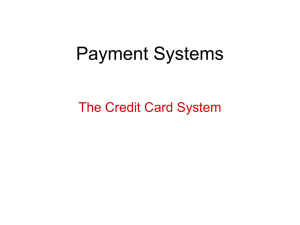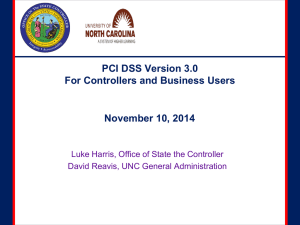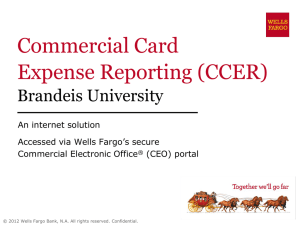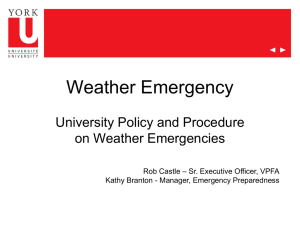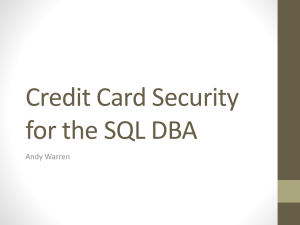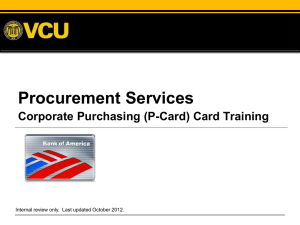Chad`s and Ruth`s presentation - Protect IU
advertisement
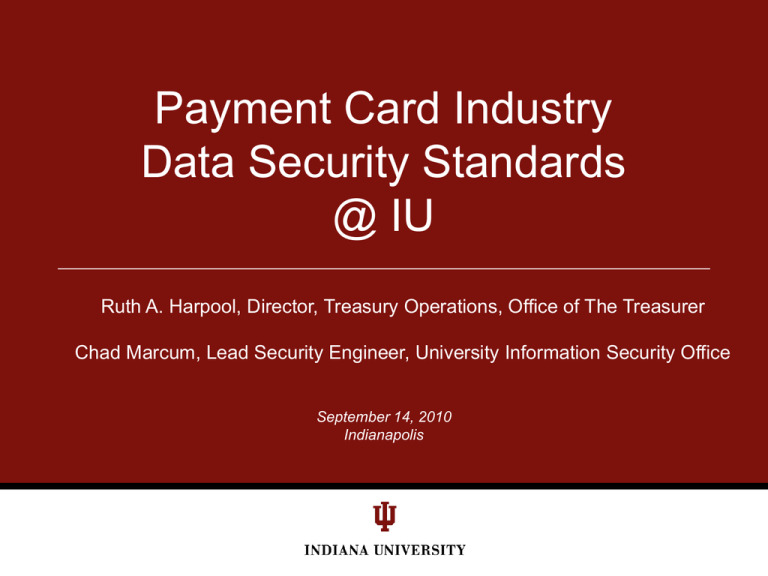
Payment Card Industry Data Security Standards @ IU Ruth A. Harpool, Director, Treasury Operations, Office of The Treasurer Chad Marcum, Lead Security Engineer, University Information Security Office September 14, 2010 Indianapolis PCI DSS Role Players @ IU • Board of Trustees • Purchasing • Merchants • Legal Counsel • Office of The Treasurer • Third Party Vendors • UISO • QSA (Trustwave) • UITS • YOU PCI DSS Relationships Merchants Credit Card Companies Indiana University Acquiring Card Office) Bank (USB) Credit(Treasurer’s Companies UISO QSA CACR Presentation • BREAK Six PCI DSS Goals • • • • • • Build and Maintain a Secure Network Protect Cardholder Data Maintain a Vulnerability Management Program Implement Strong Access Control Measures Regularly Monitor and Test Networks Maintain an Information Security Policy Security Controls and Processes for PCI DSS Requirements • • • • • • • • • • • • Build and Maintain a Secure Network Requirement 1: Install and maintain a firewall configuration to protect cardholder data Requirement 2: Do not use vendor-supplied defaults for system passwords and other security parameters Protect Cardholder Data Requirement 3: Protect stored cardholder data Requirement 4: Encrypt transmission of cardholder data across open, public networks Maintain a Vulnerability Management Program Requirement 5: Use and regularly update anti-virus software Requirement 6: Develop and maintain secure systems and applications Implement Strong Access Control Measures Requirement 7: Restrict access to cardholder data by business need-to-know Requirement 8: Assign a unique ID to each person with computer access Requirement 9: Restrict physical access to cardholder data Regularly Monitor and Test Networks Requirement 10: Track and monitor all access to network resources and cardholder data Requirement 11: Regularly test security systems and processes Maintain an Information Security Policy Requirement 12: Maintain a policy that addresses information security Top PCI DSS Violations 80% - Requirement # 1: Install and Maintain a firewall configuration Source: 2008 Trustwave Report Top PCI DSS Violations 80% - Requirement # 1: Install and Maintain a firewall configuration 75% - Requirement # 2: Do not use vendor-supplied defaults Source: 2008 Trustwave Report Top PCI DSS Violations 80% - Requirement # 1: Install and Maintain a firewall configuration 75% - Requirement # 2: Do not use vendor-supplied defaults 88 % - Requirement # 3: Protect stored cardholder data Source: 2008 Trustwave Report Top PCI DSS Violations 80% - Requirement # 1: Install and Maintain a firewall configuration 75% - Requirement # 2: Do not use vendor-supplied defaults 88 % - Requirement # 3: Protect stored cardholder data 11% - Requirement # 4: Encrypt transmission of cardholder data Source: 2008 Trustwave Report Top PCI DSS Violations 80% - Requirement # 1: Install and Maintain a firewall configuration 75% - Requirement # 2: Do not use vendor-supplied defaults 88 % - Requirement # 3: Protect stored cardholder data 11% - Requirement # 4: Encrypt transmission of cardholder data 41% - Requirement # 5: Use and regularly update anti-virus software Source: 2008 Trustwave Report Top PCI DSS Violations 80% - Requirement # 1: Install and Maintain a firewall configuration 75% - Requirement # 2: Do not use vendor-supplied defaults 88 % - Requirement # 3: Protect stored cardholder data 11% - Requirement # 4: Encrypt transmission of cardholder data 41% - Requirement # 5: Use and regularly update anti-virus software 94% - Requirement # 6: Develop and maintain secure systems and apps Source: 2008 Trustwave Report Top PCI DSS Violations 80% - Requirement # 1: Install and Maintain a firewall configuration 75% - Requirement # 2: Do not use vendor-supplied defaults 88 % - Requirement # 3: Protect stored cardholder data 11% - Requirement # 4: Encrypt transmission of cardholder data 41% - Requirement # 5: Use and regularly update anti-virus software 94% - Requirement # 6: Develop and maintain secure systems and apps 25% - Requirement # 7: Restrict access to cardholder data by need to know Source: 2008 Trustwave Report Top PCI DSS Violations 80% - Requirement # 1: Install and Maintain a firewall configuration 75% - Requirement # 2: Do not use vendor-supplied defaults 88 % - Requirement # 3: Protect stored cardholder data 11% - Requirement # 4: Encrypt transmission of cardholder data 41% - Requirement # 5: Use and regularly update anti-virus software 94% - Requirement # 6: Develop and maintain secure systems and apps 25% - Requirement # 7: Restrict access to cardholder data by need to know 63% - Requirement # 8: Assign a unique ID to each person with access Source: 2008 Trustwave Report Top PCI DSS Violations 80% - Requirement # 1: Install and Maintain a firewall configuration 75% - Requirement # 2: Do not use vendor-supplied defaults 88 % - Requirement # 3: Protect stored cardholder data 11% - Requirement # 4: Encrypt transmission of cardholder data 41% - Requirement # 5: Use and regularly update anti-virus software 94% - Requirement # 6: Develop and maintain secure systems and apps 25% - Requirement # 7: Restrict access to cardholder data by need to know 63% - Requirement # 8: Assign a unique ID to each person with access 12% - Requirement # 9: Restrict physical access to cardholder data Source: 2008 Trustwave Report Top PCI DSS Violations 80% - Requirement # 1: Install and Maintain a firewall configuration 75% - Requirement # 2: Do not use vendor-supplied defaults 88 % - Requirement # 3: Protect stored cardholder data 11% - Requirement # 4: Encrypt transmission of cardholder data 41% - Requirement # 5: Use and regularly update anti-virus software 94% - Requirement # 6: Develop and maintain secure systems and apps 25% - Requirement # 7: Restrict access to cardholder data by need to know 63% - Requirement # 8: Assign a unique ID to each person with access 12% - Requirement # 9: Restrict physical access to cardholder data 91% - Requirement # 10: Track and monitor all access to resources Source: 2008 Trustwave Report Top PCI DSS Violations 80% - Requirement # 1: Install and Maintain a firewall configuration 75% - Requirement # 2: Do not use vendor-supplied defaults 88 % - Requirement # 3: Protect stored cardholder data 11% - Requirement # 4: Encrypt transmission of cardholder data 41% - Requirement # 5: Use and regularly update anti-virus software 94% - Requirement # 6: Develop and maintain secure systems and apps 25% - Requirement # 7: Restrict access to cardholder data by need to know 63% - Requirement # 8: Assign a unique ID to each person with access 12% - Requirement # 9: Restrict physical access to cardholder data 91% - Requirement # 10: Track and monitor all access to resources 91% - Requirement # 11: Regularly test security systems and processes Source: 2008 Trustwave Report Top PCI DSS Violations 80% - Requirement # 1: Install and Maintain a firewall configuration 75% - Requirement # 2: Do not use vendor-supplied defaults 88 % - Requirement # 3: Protect stored cardholder data 11% - Requirement # 4: Encrypt transmission of cardholder data 41% - Requirement # 5: Use and regularly update anti-virus software 94% - Requirement # 6: Develop and maintain secure systems and apps 25% - Requirement # 7: Restrict access to cardholder data by need to know 63% - Requirement # 8: Assign a unique ID to each person with access 12% - Requirement # 9: Restrict physical access to cardholder data 91% - Requirement # 10: Track and monitor all access to resources 91% - Requirement # 11: Regularly test security systems and processes 75% - Requirement # 12: Maintain a policy that addresses info security Source: 2008 Trustwave Report Ten Common Myths of PCI DSS Ten Common Myths of PCI DSS Ten Common Myths of PCI DSS Ten Common Myths of PCI DSS Ten Common Myths of PCI DSS Ten Common Myths of PCI DSS Ten Common Myths of PCI DSS Ten Common Myths of PCI DSS Ten Common Myths of PCI DSS Ten Common Myths of PCI DSS Ten Common Myths of PCI DSS Build and Maintain a Secure Network Requirement 1: Install and maintain a firewall and router configuration to protect cardholder data (26 sub-requirements) Responsibility Merchants UITS Treasury UISO How can you help? Headlines Novice computer hacking kits found for sale on eBay UT Arlington File Server with Records on 27,000 Breached Four Times Submitted by Adam Dodge on Fri, 2010-07-23 06:19 Quick Facts Date: 7/23/2009 Institution: University of Texas, Arlington Type of Incident: Penetration Number Affected: 27,000 Source: ESI Abstract Source: University of Texas, Arlington Abstract The University of Texas, Arlington recently notified students, faculty and staff after the breach of a file server containing personal information. The file server, used by the university's Student Health Center, contained the names, addresses, prescription names, amount spent and diagnostic codes of 27,000 students, faculty and staff between 2000 and June 2010, including 2,048 Social Security numbers. The compromise was discovered on June 21, 2010 by IT staff and an investigation uncovered the server had been breached on four occasions between February 2009 and February 2010. Build and Maintain a Secure Network Requirement 2: Do not use vendor supplied defaults for system passwords and other security parameters Responsibility Merchants Every user, every machine UITS (13 sub-requirements) How can you help? Headlines Vendor-Supplied Backdoor Passwords – A Continuing Vulnerability Retailers Sue POS Vendor “One of the key accusations against Computer World is that it used vendor default passwords for systems with many of these restaurants, for easier remote administration. The lawsuit correctly points out that PCI bans retailers from using such vendor default passwords.” Read more: http://www.storefrontbacktalk.com/securityfraud/retailers-suingcard-processor-questions-raised-as-to-where-pci-dutiesstop/#ixzz0ymIKSDPF Protect Cardholder Data Requirement :3 Protect stored cardholder data (28 sub-requirements) Responsibility Merchants Treasury How can you help? Headlines Email Attachment Contains Arkansas State University Employee Information Submitted by Adam Dodge on Thu, 2010-09-02 06:31 Quick Facts Date: 9/2/2010 Institution: Arkansas State University Type of Incident: Unauthorized Disclosure Number Affected: 2,484 Source: ESI Headlines Laptop Stolen From Locked Office at University of Kentucky Submitted by Adam Dodge on Thu, 2010-08-19 06:32 Quick Facts Date: 8/19/2010 Institution: University of Kentucky Type of Incident: Theft Number Affected: 2,027 Source: DataBreaches.net Abstract Source: University of Kentucky Public Notice Abstract The University of Kentucky is working to notify parents after a laptop was stolen from the university's Newborn Screening Program. The laptop, which was taken from a locked office in the Department of Pediatrics Newborn Screening Program, contained the names, medical record numbers, dates of birth, diagnosis, mothers' name and mothers' Social Security numbers on 2,027. Protect Cardholder Data Requirement 4: Encrypt transmission of cardholder data across open, public networks Responsibility Merchants Treasury (4 sub-requirements) How can you help? Headlines • Encryption Implementation Really Matters • Written by Walter Conway August 26th, 2010 Read more: http://www.storefrontbacktalk.com/securityfraud /encryption-implementation-reallymatters/#ixzz0ymKXbVcS Maintain a Vulnerability Management Program Requirement 5: Use and regularly update anti-virus software or programs Responsibility Merchants UITS (7 sub-requirements) How can you help? Headlines August 17, 2000 9:15 AM PDT New strain of "Love" virus steals passwords Read more: http://news.cnet.com/2100-1023-244593.html#ixzz0ymNOafk9 February 18, 2010 : New computer virus steals your log-in info for Facebook, Yahoo and Hotmail Headlines Sep 1, 2010 Cyber Thieves Steal Nearly $1,000,000 from University of Virginia College Cyber crooks stole just shy of $1 million from a satellite campus of The University of Virginia last week, KrebsOnSecurity.com has learned. The attackers stole the money from The University of Virginia’s College at Wise, a 4-year public liberal arts college located in the town of Wise in southwestern Virginia. According to several sources familiar with the case, thieves stole the funds after compromising a computer belonging to the university’s comptroller. The attackers used a computer virus to steal the online banking credentials for the University’s accounts at BB&T Bank, and initiated a single fraudulent wire transfer in the amount of $996,000 to the Agricultural Bank of China. BB&T declined to comment for this story. Maintain a Vulnerability Management Program Requirement 6: Develop and maintain secure systems and applications Responsibility Merchants UITS (40 sub-requirements) How can you help? Headlines Even antivirus vendors warn their solutions are not enough. "A lot of people will buy one product and expect it to do everything -- and it doesn't," says GFI's Eckelberry, which recently bought security application maker Sunbelt Software. "In the past, you could rely on your AV product to catch everything, but it can't anymore. I have some of the coolest technology in the world, but I know what it is like out there. It will not catch everything." Companies should secure employees against their own behavior just as a parent childproofs a house, Eckelberry says. "It may be a terrible analogy," he says, "but as an IT manager, you have to expect that users are gong to bumble around and break glass objects." Lunch Break 12-1 Security Controls and Processes for PCI DSS Requirements • • • • • • • • • • • • Build and Maintain a Secure Network Requirement 1: Install and maintain a firewall configuration to protect cardholder data Requirement 2: Do not use vendor-supplied defaults for system passwords and other security parameters Protect Cardholder Data Requirement 3: Protect stored cardholder data Requirement 4: Encrypt transmission of cardholder data across open, public networks Maintain a Vulnerability Management Program Requirement 5: Use and regularly update anti-virus software Requirement 6: Develop and maintain secure systems and applications Implement Strong Access Control Measures Requirement 7: Restrict access to cardholder data by business need-to-know Requirement 8: Assign a unique ID to each person with computer access Requirement 9: Restrict physical access to cardholder data Regularly Monitor and Test Networks Requirement 10: Track and monitor all access to network resources and cardholder data Requirement 11: Regularly test security systems and processes Maintain an Information Security Policy Requirement 12: Maintain a policy that addresses information security Implement Strong Access Control Measures Requirement 7: Restrict access to cardholder data by business need to know Responsibility Merchants UITS (9 sub-requirements) How can you help? Headlines Study: 80% of Organizations Suffer Breaches, Most From the Inside “If you still think nameless, faceless bad hackers are the biggest threat, think again: Three quarters of all data breaches in the U.S. are at the hands of insiders at the organization -- most inadvertent, but some malicious –” Source: Security DARKreading. October 2008 http://www.darkreading.com/security/government New Facebook ID Theft scam: 'Dislike' button Monday, August 16, 2010 Charlotte Observer The Better Business Bureau warns Facebook users against clicking a ‘dislike’ button siting a new identity theft scam. Implement Strong Access Control Measures Requirement 8: Assign a unique ID to each person with computer access Responsibility Merchants UITS (25 sub-requirements) How can you help? Headlines Two Factor Authentication required for remote access. Remove/disable inactive users every 90 days. Remove terminated employee’s access immediately. • An Employee Leaves, Does Your Data Follow? Carl J. Rychcik; LTN Law Technology News: http://www.law.com Corporate Counsel November 09, 2009 • • The days of photocopying documents and sneaking out the door with hard copies are long gone. Most information is now available electronically, and large amounts of data can be copied efficiently and discreetly via computer. The good news is that in many instances, accessing information electronically leaves a distinct trail for a former employer to follow. The bad news, though, is that if the proper steps are not taken, this trail can quickly be lost. In fact, in many cases, simply doing nothing can result in valuable information being lost forever. There are a number of pitfalls to avoid when building a case against a former employee who you believe has taken your confidential information. Implement Strong Access Control Measures Requirement 9: Restrict physical access to cardholder data Responsibility Merchants UITS (24 sub-requirements) How can you help? Headlines Storm Lake, Iowa College Falls Victim to Campus Data Breach August 26, 2010 It has been confirmed that Buena Vista University, located in Storm Lake, Iowa, has fallen victim to a data breach on campus, in which a campus database was accessed without authorization sometime in June. The database that was accessed contained information going back to 1987, and included personally identifiable information on BVU students, faculty, staff, parents, alumni and even BVU donors. This information included names, Social Security numbers, and in some cases, driver’s license numbers. This breach, which was confirmed to have happened sometime in June, has caused the University to invest time and energy in contacting some 93,000 people who have been affected. Although there have been no reports of information on this database being misused, university officials have notified the proper authorities of the data breach and are taking the time to contact all who have been affected. Regularly Monitor and Test Networks Requirement 10: Track and monitor all access to network resources and cardholder data Responsibility Merchants UITS (30 sub-requirements) How can you help? Headlines Top Five Data Security Vulnerabilities Leading to Compromises 1. 2. 3. 4. 5. SQL Injection Unpatched and Unhardened Systems Malicious Software (Malware) That Captures Cardholder Data Insecure Network Configuration and Poor Monitoring Lack of audit Trail Logs According to VISA as reported on April 15, 2009 Regularly Monitor and Test Networks Requirement 11: Regularly test security systems and processes (14 sub-requirements) Responsibility Merchants UITS Treasury UISO How can you help? Headlines From University of Wisconsin-Madison this warning was issued in February 2010: A new botnet and phishing scam has the ability to steal files from (and remotely control) an infected computer. Computer.botnet is using an old tool in phishing scams aimed at collecting banking and social networking website usernames and passwords. Specifically, something called the Kneber Botnet uses Zeus trojan to steal restricted data. Zeus, also know as Zbot, is a trojan horse type malware that includes a keystroke logger. Maintain an Information Security Policy Requirement 12: Responsibility Maintain a policy that addresses information security for employees and contractors Merchants (35 sub-requirements) UISO UITS Treasury How can you help? Verizon 2010 Data Breach Report Key Findings of the 2010 Report This year's key findings both reinforce prior conclusions and offer new insights. These include: • Most data breaches investigated were caused by external sources. Sixty-nine percent of breaches resulted from these sources, while only 11 percent were linked to business partners. Forty-nine percent were caused by insiders, which is an increase over previous report findings, primarily due in part to an expanded dataset and the types of cases studied by the Secret Service. Many breaches involved privilege misuse. Forty-eight percent of breaches were attributed to users who, for malicious purposes, abused their right to access corporate information. An additional 40 percent of breaches were the result of hacking, while 28 percent were due to social tactics and 14 percent to physical attacks. • Commonalities continue across breaches. As in previous years, nearly all data was breached from servers and online applications. Eight-five percent of the breaches were not considered highly difficult, and 87 percent of victims had evidence of the breach in their log files, yet missed it. • Meeting PCI-DSS compliance still critically important. Seventy-nine percent of victims subject to the PCI-DSS standard hadn't achieved compliance prior to the breach. Source: 2010 Data Breach Report from Verizon Businesses Break Summary of PCI DSS Changes Requirement Impact Reason for Change Proposed Change Category PCI DSS Intro Clarify Applicability of PCI DSS and cardholder data Clarify that PCI DSS Requirements 3.3 and 3.4 apply only to PAN Clarification Scope of Assessment Ensure all locations of cardholder data are included in scope of PCI DSS assessments Clarify that all locations and flows of cardholder data should be identified and documented to ensure accurate scoping of environment Additional Guidance PCI DSS Intro and various requirements Provide guidance on virtualization Expanded definition of systems components to include virtual components. Updated requirement 2.2.1 to clarify intent of ‘one primary function per server” and use of virtualization Additional Guidance Source: PCI Security Standards Council Summary of PCI DSS Changes Requirement Impact Reason for Change Proposed Change Category PCI DSS Requirement 1 Further clarification of the DMZ Provide clarification on secure boundaries between internet and card holder data environment Clarification PCI DSS Requirement 3.2 Clarify applicability of PCI DSS to Issuers or Issuer Processors- Recognize that Issuers have a legitimate business need to store Sensitive Authentication Data Clarification PCI DSS Requirement 3.6 Clarify key management processes Clarify processes and increase flexibility for cryptographic key changes, retired or replaced keys, and use of split control and dual knowledge Clarification Source: PCI Security Standards Council Summary of PCI DSS Changes Requirement Impact Reason for Change Proposed Change Category PCI DSS Requirement 6.2 Apply a risk based approach for addressing vulnerabilities Update requirement to allow vulnerabilities to be ranked and prioritized according to risk Evolving Requirement PCI DSS Requirement 6.5 Merge requirements to eliminate redundancy and Expand examples of secure coding standards to include more than OWASP Merge requirement 6.3.1 into 6.5 to eliminate redundancy for secure coding for internal and Web-facing applications. Include examples of additional secure coding standards, such as CWE and CERT Clarification PCI DSS Requirement 12.3.10 Clarify remote copy, move, and storage of cardholder data Update requirement to allow business justification for copy, move and storage of CHD during remote access Clarification Source: PCI Security Standards Council Summary of PCI DSS Changes Requirement Impact Reason for Change Proposed Change Category PA-DSS General Payment Applications on Hardware Terminals. Provide further guidance on PA-DSS applicability to hardware terminals. Additional Guidance PA-DSS Requirement 4.4 Payment applications should facilitate centralized logging Add sub-requirement for payment applications to support centralized logging, in alignment with PCI DSS requirement 10.5.3 Evolving Requirement PA-DSS Requirements 10 & 11 Merge PA-DSS Requirements 10 and 11 Combine requirements 10 and 11 (remote update and access requirements) to remove redundancies Clarification Source: PCI Security Standards Council PCI DSS Timelines to Know • The planned publication date of version 2.0 of PCI DSS and version 2.0 of PA-DSS is October 28, 2010. • The updated standards will become effective on January 1, 2011. Upcoming Changes to the IU Payment Card Environment You Should Expect? • Tighter access controls on desktop and laptop computers that access IU PCI systems or are used by employees to hand key cardholder data Upcoming Changes to the IU Payment Card Environment You Should Expect? • Remote desktop requires two-factor authentication Upcoming Changes to the IU Payment Card Environment You Should Expect? • Retirement of IPAS (no later than 12/2010) Upcoming Changes to the IU Payment Card Environment You Should Expect? • Guidelines regarding Host Based firewalls for servers and systems operating within the IU PCI environment Upcoming Changes to the IU Payment Card Environment You Should Expect? • Guidance on the IU PCI VRF and what should and should not be inside of it Upcoming Changes to the IU Payment Card Environment You Should Expect? • Discontinued use of iFrames unless approved by Treasury Self-Assessment Questionnaires (SAQs) Would you rather have an A or a D? • • • • SAQ A - about 13 questions SAQ B - about 26 questions SAQ C - about 41 questions SAQ D - about 240 questions Self-Assessment Questionnaire A • Merchant does not store, process, or transmit any cardholder data on merchant premises but relies entirely on third-party service provider(s) to handle these functions • Third-party service provider(s) handling storage, processing, and/or transmission of cardholder data is confirmed to be PCI DSS compliant 4/9/2015 Self-Assessment Questionnaire A • Requirement 9: Restrict physical access to cardholder data • Requirement 12: Maintain a policy that addresses information security 4/9/2015 Self-Assessment Questionnaire B • Merchant uses only an imprint machine and does not transmit cardholder data over either a phone line or the Internet OR • Merchant uses only standalone, dial-up terminals, and the standalone, dial-up terminals are not connected to the Internet or any other systems within the merchant environment AND • Merchant does not store cardholder data in electronic format 4/9/2015 Self-Assessment Questionnaire B • Requirement 3: Protect stored cardholder data • Requirement 4: Encrypt transmission of cardholder data across open, public networks • Requirement 7: Restrict access to cardholder data by business need to know • Requirement 9: Restrict physical access to cardholder data • Requirement 12: Maintain a policy that addresses information security 4/9/2015 Self-Assessment Questionnaire C • Merchant has a payment application system and an Internet or public network connection on the same device • Merchant does not store cardholder data in electronic format 4/9/2015 Self-Assessment Questionnaire C • • • • • • • • • • • Requirement 1: Install and configure a firewall configuration to protect cardholder data Requirement 2: Do not use vendor-supplied defaults for system passwords and other security parameters Requirement 3: Protect stored cardholder data Requirement 4: Encrypt transmission of cardholder data across open, public networks Requirement 5: Use and regularly update anti-virus software Requirement 6: Develop and maintain secure systems and applications Requirement 7: Restrict access to cardholder data by business need to know Requirement 8: Assign a unique ID to each person with computer access Requirement 9: Restrict physical access to cardholder data Requirement 11: Regularly test security systems and processes Requirement 12: Maintain a policy that addresses information security 4/9/2015 Self-Assessment Questionnaire D • All other Merchants 4/9/2015 Self-Assessment Questionnaire D • • • • • • • • • • • • Requirement 1: Install and configure a firewall configuration to protect cardholder data Requirement 2: Do not use vendor-supplied defaults for system passwords and other security parameters Requirement 3: Protect stored cardholder data Requirement 4: Encrypt transmission of cardholder data across open, public networks Requirement 5: Use and regularly update anti-virus software Requirement 6: Develop and maintain secure systems and applications Requirement 7: Restrict access to cardholder data by business need to know Requirement 8: Assign a unique ID to each person with computer access Requirement 9: Restrict physical access to cardholder data Requirement 10: Track and monitor all access to network resources and cardholder data Requirement 11: Regularly test security systems and processes Requirement 12: Maintain a policy that addresses information security 4/9/2015 SAQ Validation Type Description SAQ V1.2 1 Card-not-present (ecommerce or mail/telephone order) merchants. NO face to face merchants A 2 Imprint-only, no electronic B 3 Stand-alone terminal merchants, no electronic cardholder date storage B 4 Merchants with POS systems connected to the Internet, no electronic cardholder data storage C 5 All other merchants(not included in types 1-4 above) D • SAQs • SAQs are beginning to be released. If you receive one then you are listed as our primary contact and are responsible for completing. • SAQs must be completed timely or your departments’ ability to accept credit cards may be temporarily suspended. • If you have SAQ questions contact Pmtcards@indiana.edu ASAP ie..don’t wait until the day your SAQ is due. Security Awareness Education • Provided by Trustwave • Meets PCI DSS training requirement 12.6.1 • Treasury will contact Fiscal Officers to request names and contact info of all individuals involved in any way in credit card processing. (includes full time, part time, IT staff, fiscal officers, etc..) • Names and contact info will be provided to Trustwave who will send an email to each with instructions on taking the training. Employees must pass. • This will be an annual requirement. • Is this the end or just the beginning? • Is it yesterday or tomorrow?
